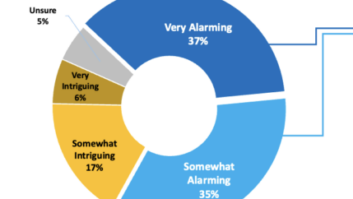The recent ruling handed down from the Copyright Royalty Board will not negatively impact on Pandora’s bottom line and future investment strategy, the company said during a conference call on Dec. 16.
The rates and terms released by the CRB’s Webcasting IV proceeding — which go into effect Jan. 1, 2016 — represent a 15% increase over the 2015 effective per-performance royalty rate. These newly established rates are to be paid by Internet radio services to performing artists and record labels for the years 2016 through 2020.
During its conference call, Pandora executives were congratulated multiple times by journalists and analysts on the call for finally having an answer on the elusive rate question. Pandora CFO Mike Herring agreed: “The decision creates certainty for our business and will help us more definitively plan and act on our vision and goals.”
(Read reactions from NAB and SoundExchange here.)
Though the company did not have advance notice as to what direction the judges would take, “we expected it to be within 15% of what we’re paying; coincidentally, it’s 15% higher,” Herring said. “Sometimes it’s better to be lucky than good, but our expectations turned out to be pretty accurate.”
The 15% increase in royalties that musicians and record labels will see is an across-the-board rate for all webcasting entities, a move that Pandora sees as positive, particularly when it comes to the series of subclassifications that can exist when determining copyright royalties.
“One of the positives [from this ruling] is that they didn’t create a lot of subclasses — it’s all webcasting, and all webcasters — to give an even playing field over the long term,” Herring said.
Despite the rate hike, said Brian McAndrews, Pandora chairman and CEO, “this is a rate we can work with and grow from. Importantly, the new structure is set at a level that allows us to aggressively invest in a vibrant and growing music ecosystem and pursue our strategic plan to build the world’s most powerful music discovery platform as well as a strong business.”
During the conference call, McAndrews confirmed that the royalty rate change would not deter Pandora’s investment in key areas, including planned new technologies spurred by the company’s purchase of assets from Rdio as well as expansion into international markets. The company hopes to launch an incremental international product before the end of 2016.
McAndrews also noted that the CRB rates will likely play a less central role in Pandora’s future business, pointing to direct licensing agreements that include publishing agreements with Sony/ATV Music Publishing and a multiyear licensing agreement with Warner/Chappell Music, which was announced on Dec. 15. The day prior, Pandora launched a hyperpersonalized station tailored to listeners’ feedback known as Thumbprint Radio, which the company called a “collaboration between each listener and Pandora.”
“So while the CRB decision is obviously an important moment, it is one of many aspects of our business,” McAndrews said. “We’ve been aggressively building a business capable of long-term growth, diversifying and adding ballast to our business, and positioning ourselves for long-term leadership regardless of CRB outcome.”
McAndrews reiterated in this call — as he has in previous conversations with analysts and the press — that company’s recent acquisitions and partnerships have set the right foundation for long-term success.
“We intend to provide music where you want it, how you want it and for everyone who wants it,” he said. “Today’s decision does nothing to change that.”
In its Q4 call in February 2016, Pandora plans to further outline the steps it will take to manage costs under these new rates. “With the right management of our cost structure and continued execution on our monetization strategies, Pandora will be able to maintain gross profit levels of 40% to 60% under the new royalty rates,” Herring said.
While the new higher rates will have a near-term impact on the profitability of Pandora’s core business, the company said the impact will be manageable and that it will be able to operate effectively in 2016 and beyond.
Industry observers see the changes as equitable. “This is an issue of fundamental fairness,” said David Leichtman, a partner with the firm Robins Kaplan. “[It provides] fairness to the talent who creates the music and fairness to the labels who invest in incubating, guiding the development of, and distributing that music.”
Leichtman said that while some companies complain that they pay a large share of their revenue in royalties, the fact is they have virtually no other overhead, he said, taking specific aim at traditional broadcasting. “For some reason, music broadcasters who have built their businesses on the backs of artists feel entitled to do so without fair and adequate compensation.”
The National Association of Broadcasters weighed in as well. “We are reviewing the CRB decision, but are pleased that streaming rates have begun to move in the right direction,” said NAB Executive Vice President of Communications Dennis Wharton. “Broadcasters want to expand into new distribution platforms; the challenge has been that rates are too high for thousands of local stations. We hope today’s decision alleviates some of the rate burden and will enable more radio stations to stream music, which will benefit artists, songwriters and our millions of listeners.”












